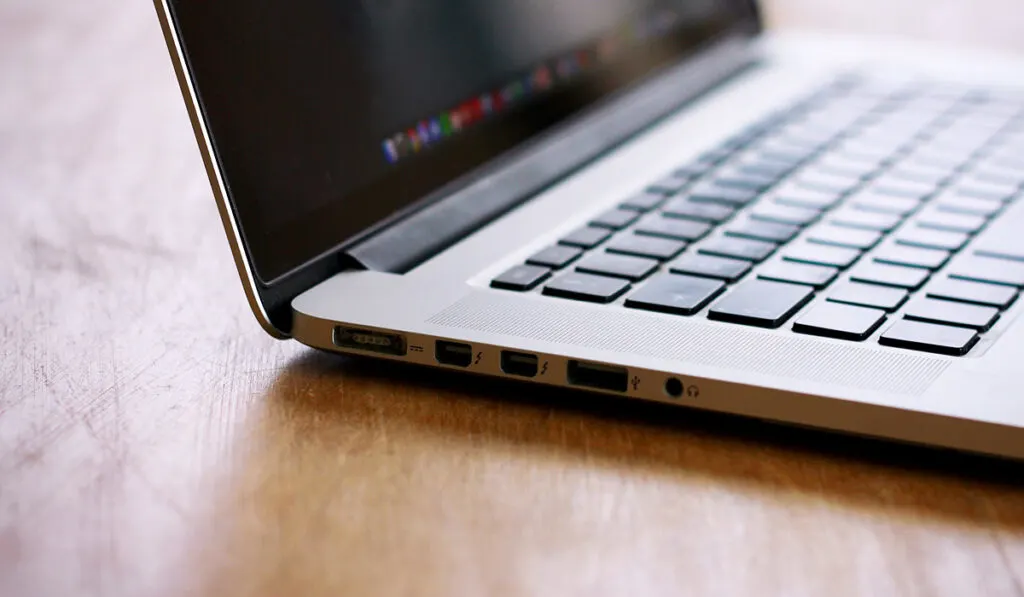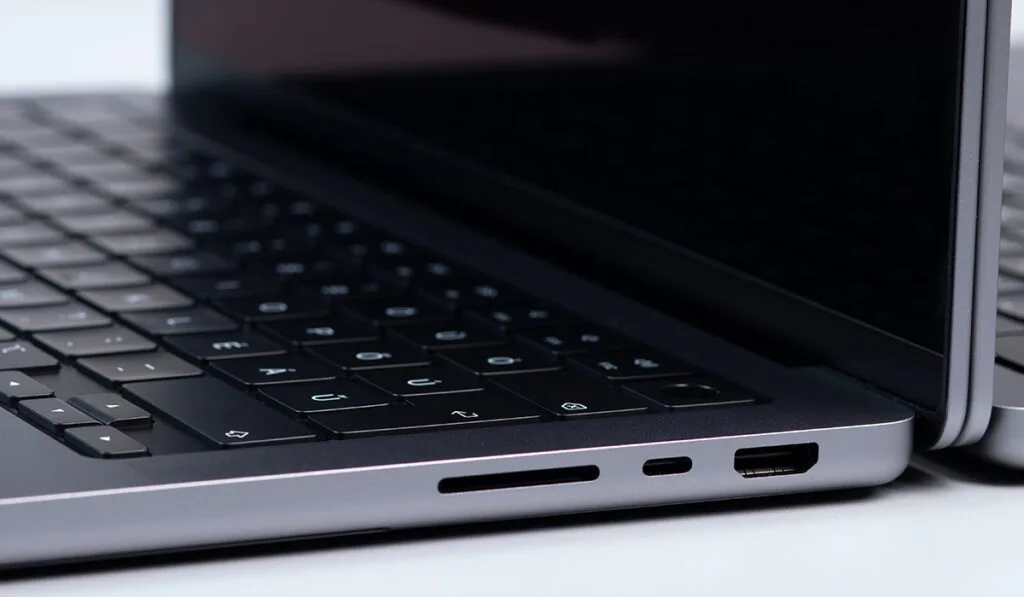What if there was a way to easily connect multiple devices with just one cable? WiFi and Bluetooth are great options, but we all know these can be painfully slow, especially when dealing with large amounts of data. That’s where MacBook’s Thunderbolt Bridge comes into play.
Thunderbolt Bridge (previously Light Peak) is a light-speed, revolutionary data transfer interface developed by Intel. It allows users to daisy-chain up to six devices together with a single Thunderbolt cable. The data transfer speed is much faster than USB 3.0 technology (up to 40 Gbps).
Just when we thought tech couldn’t get any faster, Thunderbolt Bridge appeared and has surpassed expectations. The technology has been around for a few years and is still one of the fastest data transfer solutions available. Let’s take a look at everything you need to know about Thunderbolt Bridge.
What Is Apple Thunderbolt Bridge?

The Thunderbolt Bridge feature on a MacBook is an incredibly useful tool that allows users to connect two or more external monitors, storage drives, or other peripherals to their machine without needing Ethernet, AirDrop, or WiFi.
The feature is particularly useful for those who work in multiple locations or need to access various devices on the same system.
With Thunderbolt, users can connect up to six devices at once and easily transfer data using Thunderbolt cables. This makes it much easier to switch between tasks or work on multiple projects simultaneously.
Think of it as a bridge between the MacBook and all of its connected devices. Instead of plugging into an outlet or using WiFi, Thunderbolt allows users to easily transfer data and even run multiple applications simultaneously.
Why Would You Need to Use Thunderbolt Bridge?
Because of its incredibly fast speeds, Thunderbolt is an excellent way to increase your MacBook’s productivity. It provides up to 10 Gigabits per second, allowing you to quickly transfer large files or use multiple monitors with minimal lag.
Normally, transferring enormous amounts of data using WiFi or Ethernet is extremely slow — not to mention unreliable. Thunderbolt Bridge provides a more secure and efficient way of getting the job done.
Another great feature of Thunderbolt is that it works bi-directionally, meaning you can use a single port to receive and transmit data. This is perfect for connecting external drives or devices like printers.
How Does Thunderbolt Bridge Work?
In a nutshell, Thunderbolt works by providing a bridge between devices, allowing them to connect and transfer data quickly. This connection is established using Thunderbolt (USB-C) cables. These cables connect to a Thunderbolt 3 port on one end, and the other end is connected to a compatible device.
The bridge provides a direct connection between two devices and allows them to communicate quickly over a short distance. The speed is determined by the Thunderbolt 3 protocol, which supports data transfer speeds up to 40 gigabits per second.
What Are the Pros and Cons of Thunderbolt?

Like any technology, Thunderbolt has its drawbacks too. Here are a few pros and cons that you should be aware of:
Pros of Thunderbolt
- One of the major advantages that Thunderbolt offers is its reliable performance and incredibly high throughput speeds. It can transfer data at rates up to 10 Gbps (40Gbps for Thunderbolt 3), making it insanely fast when compared to AirDrop or WiFi.
- Thunderbolt can connect two computers and transfer data between them, creating a sort of “local area network.”
- Thunderbolt 3 and later versions of the technology support four 4K displays or one 5K display and can also work with Microsoft Windows.
Cons of Thunderbolt
- Thunderbolt 1 and 2 were only compatible with Apple devices. However, Apple has since rectified this with Thunderbolt 3 and later.
- It’s easy to confuse Thunderbolt and USB-C ports since they look very similar, but the two are quite different.
- This tech is expensive, and many laptops and PCs don’t come with Thunderbolt ports. If you want to use Thunderbolt, you’ll likely have to purchase an adaptor or dongle.
Can You Plug Thunderbolt Into USB-C?
Initially, with the Thunderbolt 1 and 2 versions, you couldn’t plug them directly into a USB-C port. But Apple improved this with the Thunderbolt 3 and later versions. Thunderbolt 3 is now compatible with USB-C and can be used interchangeably.
However, your USB-C cable needs to be of good quality if it’s going to work as a Thunderbolt cable. Usually, the cable should be labeled as “Thunderbolt Certified” for it to work.
Can You Connect Multiple Monitors Through Thunderbolt?
Yes, you can connect multiple monitors to your MacBook via Thunderbolt. For Mac computers with Thunderbolt 2 ports, you can connect up to two displays. For Mac computers with Thunderbolt 4 ports, you can connect up to four displays.
You’ll need either a Mini DisplayPort or a Thunderbolt cable for each monitor. You may want to invest in a Mini DisplayPort or Thunderbolt cable (on Amazon) that supports 4K or 5K resolutions to get the best performance and highest resolution.
It’s important to note that you can connect up to 6 devices to each thunderbolt port if you chain them. Chaining allows you to connect two or more thunderbolt devices using multiple ports.
Here’s how to do it:
- Connect the first device to your MacBook with a Thunderbolt or Mini DisplayPort cable.
- Plug the second Thunderbolt device into the other end of the port, and so on.
Where Did Thunderbolt (and USB-C) Come From?

If you upgrade from the MacBook to the MacBook Pro, you may have noticed that plugging in new accessories can be a confusing experience. That’s because Apple replaced the old MagSafe ports with new USB-C ports.
This has been very frustrating for many users. Having the USB-C ports means that you need to purchase a lot of new cables when you upgrade your laptop.
In a time when tech is advancing, the last thing many of us want is to be bogged down by cables. Not to mention that these cables are expensive and sometimes unavailable in stores. So, was introducing the USB-C ports in MacBooks a wrong move by Apple?
This script sounds familiar to the butterfly keyboards controversy — remember all those class action lawsuits? It was so bad that many users opted to stick or buy old model Macs instead of investing in brand new ones.
USB-C and MagSafe
New leaks from trusted sources show that Apple is re-introducing the MagSafe ports on the upcoming M1X MacBooks. It would seem that Apple is finally giving in to its customers’ demands and bringing back what everyone loved. Or maybe all this was part of the plan?
One fairly unknown fact is that Apple was behind the design of the USB-C cables. Yes, Apple created the technology but then didn’t want to take all the credit for it. Instead, they were only listed as contributors.
If you’re wondering why they did this, it’s because if the cables were called Apple USB-C cables, most companies wouldn’t want to adopt it and make Apple look good. A wiser move would be to let the industry embrace and own it.
Even though 5 years down the line, the MagSafe ports are back to their old spots, the USB-C ports paved the way for most of today’s devices. Almost all computers, even those not developed by Apple, feature at least one USB-C port.
The USB ports also made it possible to design MacBooks to be as thin as possible. We all know how obsessed with thinness Apple is. The 24-inch iMac, for instance, is so thin that the USB-C is the only port that can fit on its side.
The USB-C cables and ports allowed Apple to achieve this goal while making the design sleek and modern looking. Now Apple can make its products thin and sleek without forcing anyone to purchase the USB-C ports. Pretty smart if you think about it.
Thunderbolt Bridging the Future
Thunderbolt is a revolutionary technology that has the potential to revolutionize data transfer speeds and more. It’s fast, reliable, and secure, which makes it perfect for tasks such as gaming, video editing, and streaming.
As more devices come with Thunderbolt ports (both pre-installed and sold separately), more and more people will be able to take advantage of this technology. The future looks bright for Thunderbolt, and it’s an exciting time to see what new possibilities it could bring.
